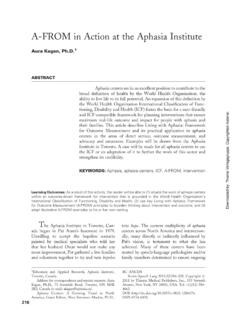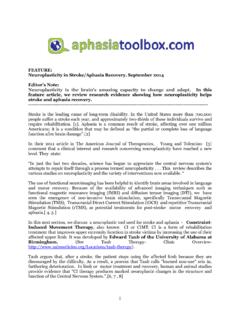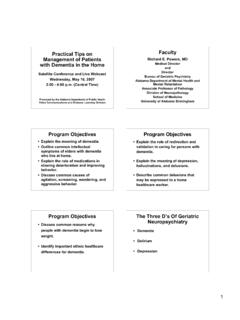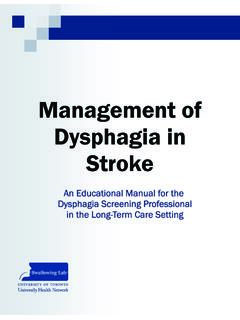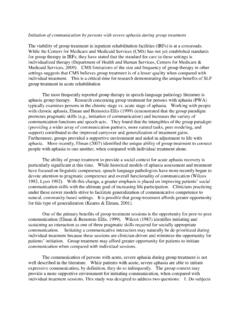Transcription of Life Participation Approach to Aphasia: A Statement of ...
1 life Participation Approach to aphasia : A Statement of Values for the Future LPAA Project Group (in alphabetical order): Roberta Chapey, Judith F. Duchan, Roberta J. Elman, Linda J. Garcia, Aura Kagan, Jon G. Lyon, and Nina Simmons-Mackie Unprecedented changes are occurring in the way treatment for aphasia is viewed and reimbursed. These changes, resulting from both internal and external pressures, are influencing how speech-language pathologists carry out their jobs. Internal influences include a growing interest in treatments that produce meaningful real life outcomes leading to enhanced quality of life .
2 Externally, we are influenced by disability rights activists encouraging adjustments in philosophy and treatment and by consumers frustrated by unmet needs and unfulfilled goals. Most recently, a strong external influence is emanating from the curtailment of funding for our work that has caused a significant reduction in available services to people affected by aphasia . To accommodate these varied influences on service delivery, it is important to take a proactive stance. We therefore propose a philosophy of service delivery that meets the needs of people affected by aphasia and confronts the pressures from our profession, providers, and funding sources.
3 Our Statement of values has been guided by the ideas and work of speech-language pathologists as well as by individuals in psychology, sociology, and medicine. We intend neither to prescribe exact methods for achieving specific outcomes, nor to provide a quick fix to the challenges facing our profession. Rather, we offer a Statement of values and ideas relevant to assessment, intervention, policy making, advocacy, and research that we hope will stimulate discussion related to restructuring of services and lead to innovative clinical methods for supporting those affected by aphasia . DEFINING THE Approach The life Participation Approach to aphasia (LPAA) is a consumer-driven service-delivery Approach that supports individuals with aphasia and others affected by it in achieving their immediate and longer term life goals (note that Approach refers here to a general philosophy and model of service delivery, rather than to a specific clinical Approach ).
4 LPAA calls for a broadening and refocusing of clinical practice and research on the consequences of aphasia . It focuses on re-engagement in life , beginning with initial assessment and intervention, and continuing, after hospital discharge, until the consumer no longer elects to have communication support. LPAA places the life concerns of those affected by aphasia at the center of all decision making It empowers the consumer to select and participate in the recovery process and to collaborate on the design of interventions that aim for a more rapid return to active life . Theses interventions thus have the potential to reduce the consequences of disease and injury that contribute to long-term health costs.
5 THE ESSENCE OF LPAA We encourage clinicians and researchers to focus on the real- life goals of people affected by aphasia . For example, in the initial stages following a CVA, a goal may be to establish effective communication with the surrounding nursing staff and physicians. At a later stage, a life goal may be to return to employment or Participation in the local community. Regardless of the stage of management , LPAA emphasizes the attainment of re-engagement in life by strengthening daily Participation in activities of choice. Residual skill is thus seen as only one of many requisites.
6 For example, full Participation is dependent on motivation and a consistent and dependable support system. A highly supportive environment can lessen the consequences of aphasia on one s life , whatever the language impairment. A nonsupportive environment, on the other hand, can substantially increase the chance of aphasia affecting daily routines. Someone with mild aphasia in a nonsupportive environment might experience greater daily encumbrances than another with severe aphasia who is highly supported. 1In this broadening and refocusing of services, LPAA recommends that clinicians and researchers consider the dual function of communication transmitting and receiving messages and establishing and maintaining social links.
7 Furthermore, life activities do not need to be in the realm of communication in order to deserve or receive intervention. What is important is to judge whether aphasia ffects the execution of activities of choice and one s involvement in them (see Table 1 for a few examples of how LPAA may lead to a broadening and refocusing of services). THE ORIGINS OF LPAA Functional and Pragmatic Approaches LPAA draws on ideas underlying functional and pragmatic approaches to aphasia nad shares some common values with those who take a broad Approach to functional communication treatment by focusing on life Participation goals and social relationships.
8 In our view, however, the term functional does not do justice to the breadth of this work. In addition, the term is often used narrowly to mean functional independence in getting a message across. Although LPAA recognizes the value of this type of impairment-level work, it should form part of a bigger picture where ultimate goal for intervention is re-engagement into everyday society. Human Rights Issues and Consumers Goals LPAA is a means of addressing unmet needs and rights of individuals with aphasia and those in their environment. Indeed, the Americans with Disabilities Act (ADA), signed into law on July 26, 1990, requires that physical and communication access be provided for individuals with aphasia and other disabilities and allows them legal recourse if they are blocked from accessing employment, programs, and services in the public and private sectors.
9 In 1992, ASHA provided guidelines for a communication bill of rights (National Joint Committee for the Communicative Needs of Persons with Severe Disabilities). Its preface states that all persons, regardless of the extent or severity of their disabilities, have a basic right to affect, through communication, the conditions of their own existence. Communication is defined as a basic need and basic right of all human beings (p. 2). ASHA thus views communication as an integral part of life Participation . Emphasis on Competence and Inclusion LPAA philosophy embraces a view of treatment that emphasizes competence and inclusion in daily life , focusing as much on the consequences of chronic disorders as on the language difficulty caused by the aphasia .
10 Along with other movements in education and health care, LPAA shifts from a focus on deficits and remediation to one of inclusion and life Participation (see Fougeyrollas et al., 1997; WHO, ICIDH-2, 1997). Such international changes in focus point to the need to address the personal experience of disability and promote optimal life inclusion and reintegration into society. Changes in Reimbursement and Service Delivery Health care and reimbursement in America have undergone an unprecedented overhaul. Financial exigencies have led to an emphasis on medically essential treatments and others seen as likely to save on future health care costs.
